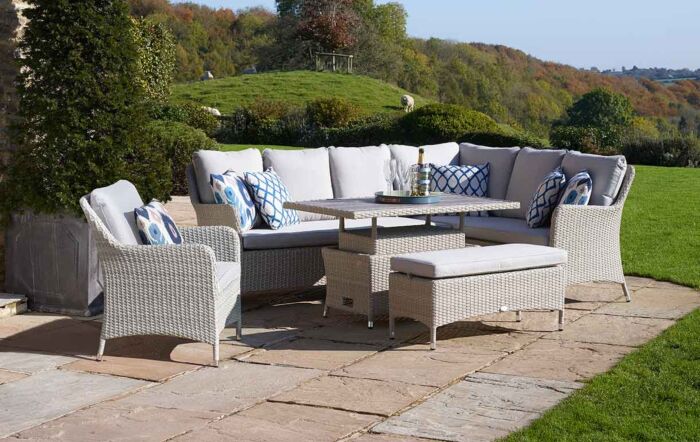Is it Ok to Leave Garden Furniture in the Rain?
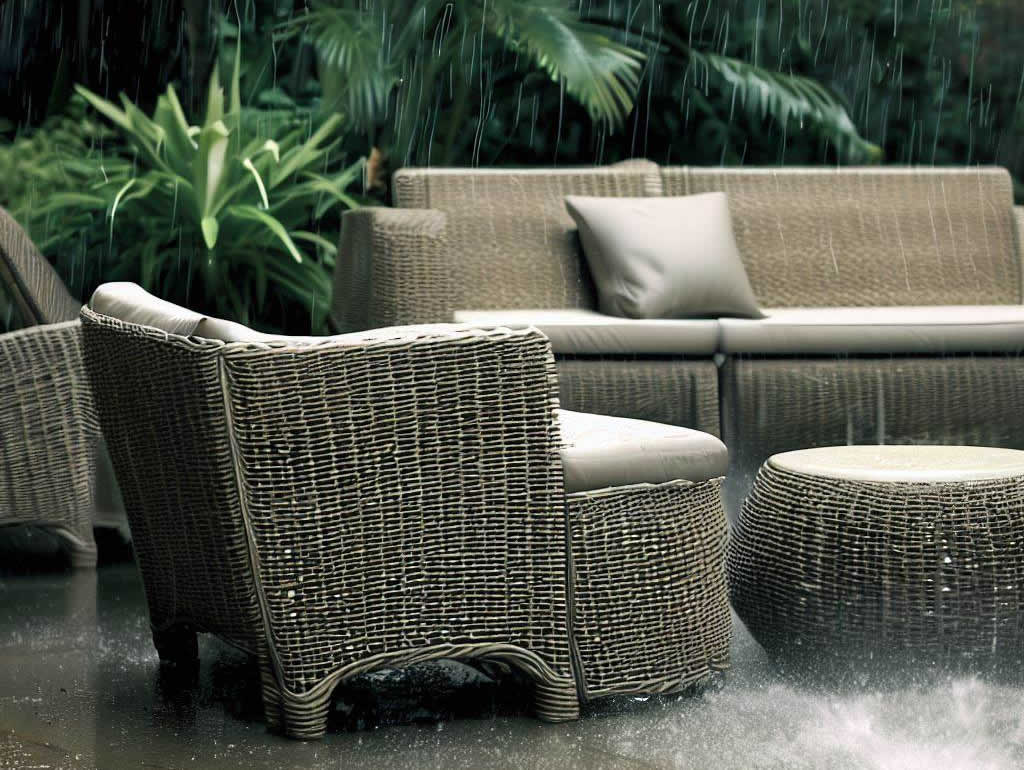
If there’s one thing we can rely on in the UK, it’s unpredictable weather. It’s not unheard of for a glorious summer's day to quickly turn into a torrential downpour.
But how do we prepare for inconsistent weather? And more specifically, wet weather?
When searching for patio furniture that’s going to live outside, ensuring it can withstand the Great British weather with minimum maintenance should always be a top buying factor.
If you’re wanting to leave your garden furniture out all year - and don’t want to replace it regularly - then it’s always worth investing in a high-quality set that’s designed to withstand all types of weather, if your budget allows. Pair that with a few simple care and maintenance steps and you’re bound to get the best out of your outdoor space for many years to come.

Can garden furniture be left out in the rain?
Yes, garden furniture can be left out in the rain, but for how long it withstands the rain depends on the material it’s made from and how often it's exposed to it.
You can buy excellent luxury garden furniture that is weather-proofed and low maintenance. However, in our experience, even the most robust garden furniture will benefit from not being constantly exposed to extreme weather such as rain, snow, hail, wind or full sun if it can be helped.
Does rain ruin garden furniture?
Unfortunately, rain can ruin some garden furniture and even the most weatherproof materials will suffer over time.
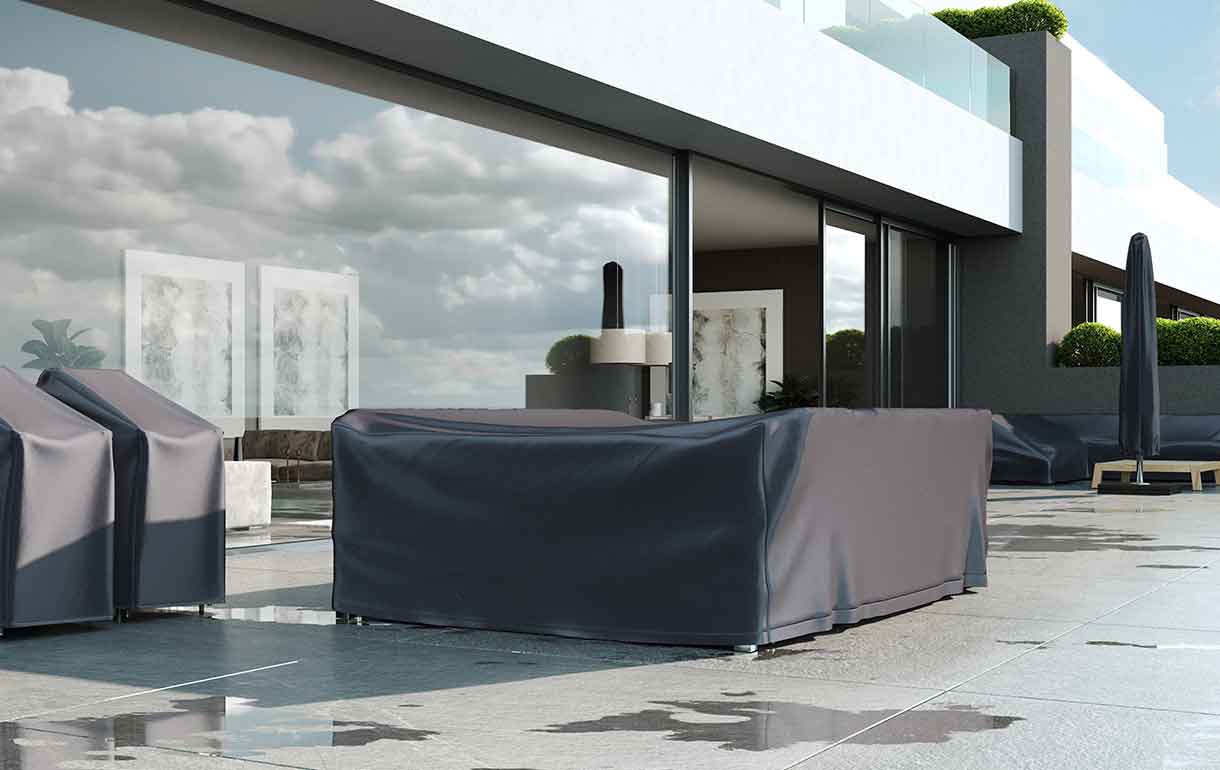
From mild discolouration to rust and rot, damage to your garden furniture is inevitable if it is exposed to damp and wet weather on a regular basis. It doesn’t necessarily mean you can’t leave it out in the rain, just take care to dry it between downpours so it doesn’t soak in, and invest in some good quality water-resistant furniture covers. This will protect your garden furniture from the worst of the wet weather.
If you live in a coastal area, the saltiness of the air and rain can add an extra layer of issues when it comes to garden furniture, so manually drying off and cleaning regularly is really beneficial in this case and can help prevent any further erosion.
What do I do if my garden furniture gets wet?
If your garden furniture gets wet, the first thing to do is to remove the excess water so it doesn’t collect in puddles anywhere. Then, ideally, allow it to dry thoroughly in the open air and warm sunshine, or dry it off manually with a soft cloth.
Keep moving it into the sunniest position, making sure to turn over cushions and open up umbrellas and parasols. This will help prevent mould and mildew from taking hold. If mould has started to grow, use a soft brush and mild soapy water to gently remove it (and any food and drink spills you come across).
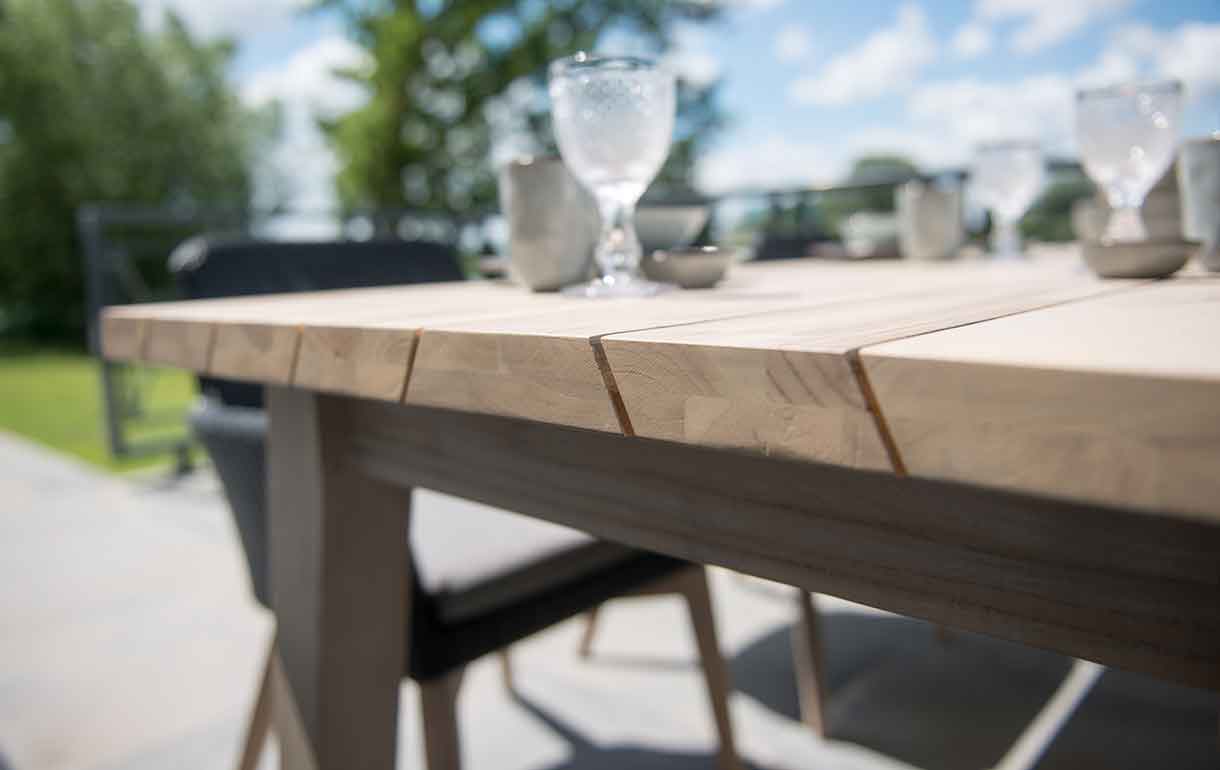
Then, take a close look to see whether you need to re-seal or re-paint any of your furniture. For example, if wooden patio furniture gets too dry it can become brittle and crack, which then allows moisture to get deep into the grain, this moisture can then cause the wood to swell when the colder weather sets in. Adding a sealant will also help preserve the colour of wood.
Whatever you do, don’t put a cover on wet furniture. This will trap moisture and prevent the furniture from “breathing”.
How often should I waterproof garden furniture?
How often you need to waterproof your garden furniture depends on the furniture itself.
Check the manufacturer’s instructions on applying sealants and anti-corrosion paint as this may only be necessary after a few years’ use, or in certain environments.
The more natural the material (e.g. wood), the more weatherproofing you’ll need to do, especially if you plan to leave it out all year. However, if you manage to keep your furniture under cover and don’t let it get too wet, your maintenance tasks are likely to be minimal.
The porous nature of softwood (such as pine) means it’s more prone to moisture penetration, which can lead to rot and decay. It’s also more likely to suffer from insect and fungal growth, reducing the lifespan of the basic structure.
Hardwood garden furniture (such as oak and teak) has a much more dense circular cell structure with a higher natural oil content - which is both a water and insect repellant - making them more suitable woods for outdoor furniture that's to be left out all year round.

Treating or painting your wooden furniture, regardless of wood type, can help prevent cracks and rotting caused by moisture. Just be sure to follow the manufacturer’s guidelines and use the correct type of treatment for the wood (if you’re unsure, just get in touch and we can help you find the right product). We’d recommend treating wooden garden furniture at least once a year.
At the other end of the scale, rattan garden furniture is purposefully designed to be left outside, so shouldn’t require any waterproofing as by nature, this material is already water and UV resistant.
What type of patio furniture is most weather resistant?
Synthetic rattan is one of the most weather resistant types of patio furniture. In particular, those products at the premium end of the market as they’re more likely to mimic the different weave styles and fibre structure used in natural rattan furniture, as opposed to the all over flatweave most often found on cheaper products.
The next most weather-resistant patio furniture types are powder-coated aluminium and teak. However, these materials may require periodical treatments or touch ups beyond the regular cleaning to keep them at their best.
After style and looks, the most important feature to look for when buying garden furniture is durability and low-maintenance. This includes making sure that any accessories such as cushions, parasols and covers, are also made from waterproof and UV-resistant materials.
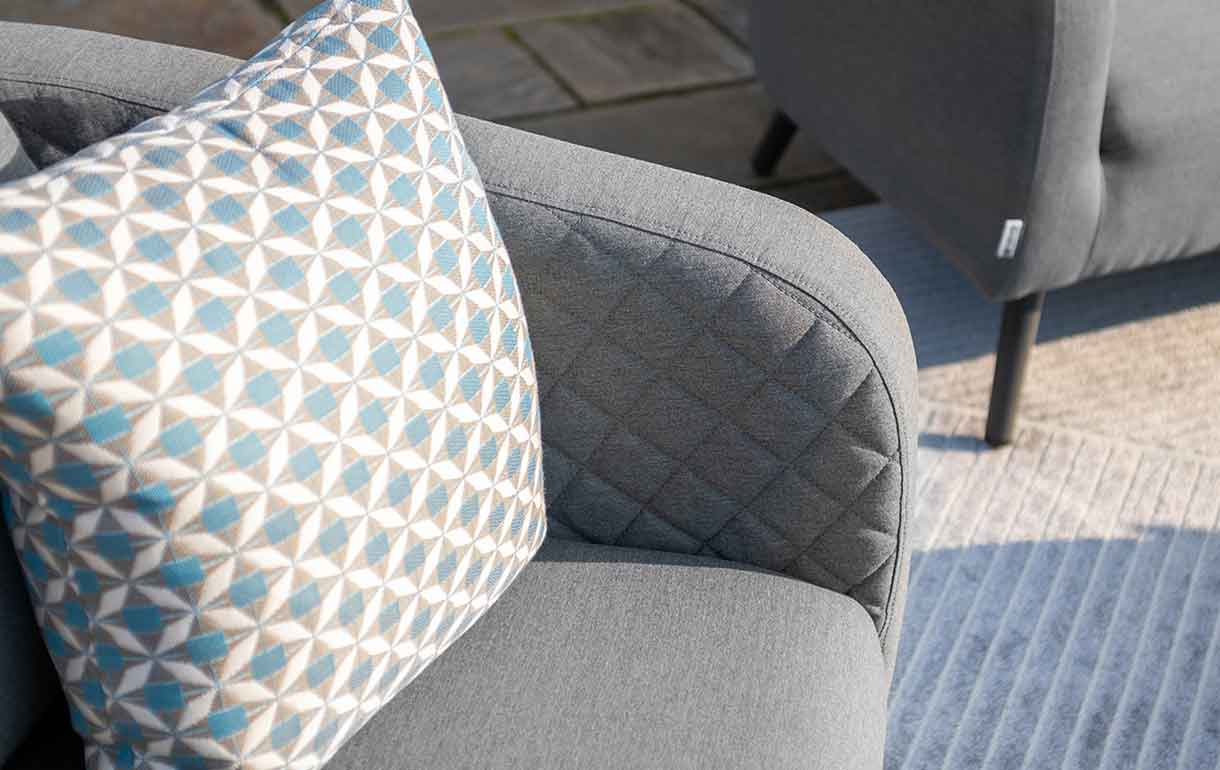
When it comes to outdoor cushion care, it’s not just a case of throwing them in the washing machine to keep them fresh either, so this is another thing to think about when buying.
Bear in mind that, depending on where you are in the UK and where you plan to position the furniture, it could be subjected to not only rain, but sun, wind, snow and saltwater too, so it’s important to check out the manufacturer’s care instructions before you buy to ensure the furniture is right for you.
What type of patio furniture can be left outside in the winter?
Any type of patio furniture can be left outside over winter, but furniture that’s made from either synthetic or weather-resistant material will withstand it the best. So, again, PE rattan and aluminium garden furniture are good choices in this case.
It is however worth bearing in mind that aluminium is very lightweight. This means it’s unsuitable for high-rise balconies, or anywhere that’s more susceptible to high winds, as there’s a greater risk of it blowing over and getting damaged.

Wood being a natural material, prefers to be out in the open air. However, it does benefit from having a treatment applied, such as oil, wax or suitable paint, as this will both feed and protect the wood from the elements.
Even the most durable furniture, regardless of type and material, will benefit from some maintenance such as cleaning away food, drink, pet hair and bird droppings. You may also need to carry out minor repairs to chips and scratches from time to time.
Giving your furniture a thorough clean and dry at the end of the summer season is always a good idea, especially if you plan to cover it as this will help prevent mould and mildew growth, ensuring it lasts even longer. Likewise, a maintenance check at the end of winter to ensure your garden furniture is summer-ready, means that any potential issues can be sorted before you head into the warmer months.
How do I make my patio furniture usable in the winter?
There are a number of things you can do to make your patio furniture usable in the winter:
- Firstly, choose furniture made from synthetic materials such as PE rattan or powder-coated aluminium as these are both non-porous and are easy to wipe dry if needed.
- If you can, position your furniture in a spot that’s least likely to be affected by harsh weather conditions. This will reduce the chances of build up from snow, leaves and debris, damage from the wind, etc.
- If you have wooden furniture, stand it on bricks when not in use so the base/feet aren’t submerged in water for long periods of time.
- If possible, store your furniture in a shed or conservatory during the worst of the winter weather. If this isn’t possible, ensure you remove any cushions and bring them inside when not in use.
- As mentioned previously, invest in water and UV-resistant furniture covers because even the toughest materials can suffer when exposed to long periods of poor weather. However, we would still recommend removing any cushions before putting a cover on to ensure they remain completely dry and mildew-free.
- Don’t be inclined to weigh down your garden furniture to prevent it flying away, as this can cause it to warp, especially as it expands and retracts with the changing temperatures.
- If you have a outdoor garden sofa, introduce a fire pit to your patio space, not only will this make your patio furniture usable all year round, the added warmth will help dry out any dampness in the area.
--------------------
Have further questions about weather protection or unsure which garden furniture to buy? Our friendly, knowledgeable team are always on hand to help, just give us a call or visit one of our showrooms.
About the Author

Chloe Shaw is a Garden Furniture & Conservatory Furniture Specialist with many years of experience working at JB Furniture. Chloe combines her deep knowledge of garden furniture trends with her talent for creating engaging and informative content. She loves sharing inspiration, design tips, and product insights to help readers transform their gardens and conservatories into beautiful and inviting retreats.










